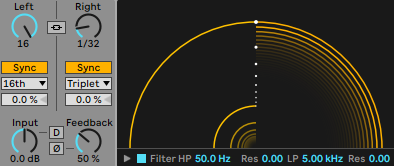
Delays are a fantastic mixing effect, and there are tons of incredible delay plugins that can help you. But mixing delays can be hard – especially since producers tend to throw it on almost any sound they can find.
This article unveils five common delay mistakes producers make.
Let’s start with the first one, never automating your delays.
1. Never Automating Delays

A great way to make your mixes more interesting is automating your delays effects. Many producers slap delays on instruments without ever automating their parameters throughout a track. Doing this can make your mix stale and repetitive.
By changing the way your delay behaves throughout your track, you have something new constantly happening, making your mix more interesting. You can change the delay feedback, dry and wet, or even the delay type or timing.
And the thing is, you don’t have to go overboard with automation. Small changes can make a big impact – especially if you introduce these changes in choruses or drops.
Automate your delays to keep your mix flowing and interesting.
2. Using Too Many Delays

Do you know what often happens when there are too many delays in a track? When producers use delays on too many sounds without a clear reason, it can get hard for listeners to focus on one thing. Your mix becomes a bouncy soup.
Often, you need dry sounds to complement your wet sounds. In terms of delay, this means using sounds without delay as a foundation and delays purposefully behind it. This combination of dry and wet gives your track balance and allows the listener to focus.
To make clear mixes, use delays with purpose and don’t throw it on every sound.
3. Always Using Wide Delays

You don’t want all your sounds to be wide. Mono exists for a reason and is often used for sounds that you want the listener to focus on. The lowest frequencies of your bass, for example.
The same thing can be true for using wide delays. Many producers use the widest type of delay on every sound, making your tracks sound too confused and diffused. When using delay, think like a mixing engineer.
And think about filling your stereo spectrum. One best practice is reserving extreme stereo widening for the highest frequencies. In other words, go narrow for lower frequencies and wider for high frequencies.
Sometimes, you also want to do the opposite. But do it purposefully. Mono delays exist for a reason and can make your mix sound more focused.
4. Forgetting Rhythm

Another common delay mistake is using delays on any random timing, regardless of how that timing relates to the rhythm of your other sounds. Doing that often hurts your mixes more than it helps. Because if an effect doesn’t enhance your mix, chances are it does the opposite.
When mixing your delays, consider rhythm and always listen to your delay with the entirety of your mix playing simultaneously. Try making your delays groove with the rest of your drums, percussion, and other sounds. Use it to enhance your rhythm.
5. Never Combining With Reverbs

When mixing, you don’t want to make every sound crystal clear. Balance is using contrast, making some sounds sit more in the background and supporting sounds in the forefront of your mix. However, sometimes, delays can be too clear – until you use reverbs.
Reverbs work in fantastic combination with delays because it diffuses the delay signal and can create a more rhythmic pulsation of reverb. You can use this to your advantage on sounds you want to keep more in the background.
It also works great on sounds where you want to diffuse the delay effect. Soft pad plucks, or ear candy is great examples where reverbed delays can work. Use it when you want to soften delays and reduce the risk of them taking over your mix.
Summary
You now have a clear idea of what delay mixing mistakes to avoid and why. And it has probably become clearer to you why using too many reverbs or using them in the wrong way can hurt your mix.
Luckily, these mistakes are easily fixable. Take automation, for example. If you never automate your delays, you can start in literally minutes.
Change the parameters of your delays throughout your mix, and you suddenly get music that’s more interesting and more pleasurable to listen to.
Use delays with purpose – and your mixes will sound better as a result.
Thanks for reading, and see you in the next article.
 Pelle Sundin is a Swedish music producer and writer, active with his chillout project PLMTRZ. He also produces psytrance. When he's not producing, he surfs, skates, and chugs coffee. |

